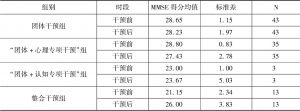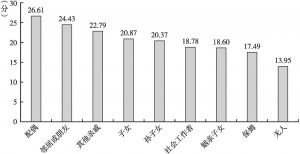报告
北京市老年人认知功能社区干预研究
摘要
结合城乡区域特征,本研究分别在北京农村社区采取干预实验方式,在城市社区采取深度访谈方式开展研究,旨在探讨存在于社区中的北京市老年人认知健康保护因素和干预方案。通过研究主要有以下发现:第一,老年人认知干预项目不仅对老年人的认知健康有积极作用,而且对于老年人的心理健康、生存质量、社会支持水平等都有一定的积极作用;第二,心理健康干预和社会支持水平的提升并不能直接提升老年人的认知健康水平,需要有专门的认知干预方案作为支撑;第三,社区公共服务对于老年人认知健康的积极作用需要建立在动员老年人参与的基础上;第四,整合干预模式是一种更加可取的认知健康干预方案;第五,需要跳出“重机构、轻社区”“重治疗、轻预防”的传统模式,从社区环境营造、专家支持、社区中各种社会支持力量的发掘入手,找寻存在于社区中的老年人认知健康关键保护因素,增强老年人的抗逆力,应对脆弱性风险。
作者
薛伟玲 ,博士,中共北京市委党校(北京行政学院)社会学教研部(北京市人口研究所)副教授,主要研究方向为人口经济学、老年健康。
检索正文关键字
报告目录
-
一 干预研究基本情况
- (一)北京市老年人认知功能社区干预数据库基本构成
- 1.干预村和参照组选定过程
- 2.参照组和干预组性别构成
- 3.参照组和干预组年龄构成
- 4.参照组和干预组教育构成
- (二)参照组和干预组的划分依据
- (一)北京市老年人认知功能社区干预数据库基本构成
-
二 认知功能社区干预具体方案
- (一)核心概念的界定
- 1.认知功能变量的界定
- 2.实验分组变量的界定
- (二)具体干预方案
- (一)核心概念的界定
-
三 直接效果分析
- (一)总体上社区干预活动对老年人认知功能起到了积极作用
- (二)不同干预方案效果比较:矛盾的结果
- (三)干预效果的显著差异存在于有认知专项干预组与其他组别之间
- (四)对分组干预结果的几点思考
- 1.心理健康干预方案和社会支持水平提升对于老年人认知健康的积极作用需要认知健康干预方案作为支撑
- 2.社区公共服务对于老年人认知健康产生积极作用需要考虑对于老年人的动员参与
- 3.整合干预模式对于老年人认知健康而言是一种更加可取的方案
-
四 社区干预间接效果分析
- (一)干预组老年人心理健康状况变化情况
- 1.干预项目对老年人抑郁的改善效果分析
- 2.干预项目对老年人孤独的改善效果分析
- (二)干预组老年人生存质量变化情况
- (三)干预组老年人社会支持水平的变化情况
- 1.干预组老年人社会支持水平变化情况
- 2.干预组老年人各类社会关系的变化情况
- (一)干预组老年人心理健康状况变化情况
-
五 北京市老年人认知功能社区干预中关键保护因素探讨
- (一)社区文化建设:营造一个无偏见的社区
- (二)研究者的力量:需要转换的身份
- (三)多种社会支持:应对脆弱性,增强抗逆力
- 六 结论和讨论
相关文献
查看更多>>>













